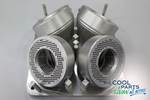Binder Jetting Vs. Metal Injection Molding: The Cool Parts Show All Access
Alpha Precision Group, provider of both processes, discusses considerations that go into making this choice.
Binder jet additive manufacturing and metal injection molding (MIM) have elements in common: Both start with powder metal, both require sintering. Because of the need to invest in a mold, MIM favors higher production volumes. Binder jetting makes lower-volume production more cost-effective.
In episode #74 of The Cool Parts Show, we described how capo maker Paige Musical Products made this choice two different ways. Its guitar capos are made via MIM, but banjo capos are made through binder jetting. But there is more than just volume that goes into considering these two processes, according to Alpha Precision Group (APG), a provider of both types of production.
In this companion to our episode on the Paige capo, APG Engineering Director Dave Smith describes other factors that are meaningful in evaluating binder jetting vs. MIM.
Related Content
-
3D Printed Capo for Banjo Made With Binder Jetting not MIM: The Cool Parts Show #74
New market, no mold tooling needed: Additive manufacturing via binder jetting enables a maker of guitar capos to expand to serve banjo players as well.
-
Tritone, DSH Technologies Launch Outsource Sintering Furnace-Access Program
Through the Furnace-Access program, Tritone customers will have immediate access to Elnik sintering furnaces and metallurgy expertise with no upfront capital investment or additional staffing required.
-
Chuck Jaws Achieve 77% Weight Reduction Through 3D Printing
Alpha Precision Group (APG) has developed an innovative workholding design for faster spindle speeds through sinter-based additive manufacturing.











